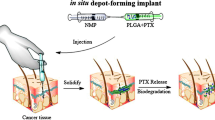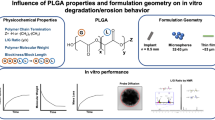Abstract
Based on UV-LIGA technology, a novel drug delivery microsystem is proposed to eliminate the time lag in initial drug release. With proper microholes in bonding membrane, the drug release rate can be controlled at a stable level in the whole release process. This microsystem is fabricated by degradable polymer and suitable for subcutaneous implants. As a significant parameter, the demarcation time of polymer absorption/erosion is estimated by comparing the experimental results of polymer erosion and in vitro release. By considering diffusion, swelling and erosion mechanisms simultaneously, a numerical drug releasing model is developed to investigate the effect of microholes on drug release and impact factors of linear drug releasing. The simulation results show that the microholes are beneficial to eliminate the time lag, and furthermore, the area of microholes and the initial drug loading have great impact on the release time and the linear drug release rate.








Similar content being viewed by others
References
Ahmed F, Discher DE (2004) Self-porating polymersomes of PEG-PLA and PEG-PCL: Hydrolysis-triggered controlled release vesicles. J Control Release 96(1):37–53
Amirouche F, Zhou Y, Johnson T (2009) Current micropump technologies and their biomedical applications. Microsyst Technol 15(5):647–666
Charlier A, Leclerc B, Couarraze G (2000) Release of mifepristone from biodegradable matrices: Experimental and theoretical evaluations. Int J Pharm 200(1):115–120
Dokoumetzidis A, Papadopoulou V, Macheras P (2006) Analysis of dissolution data using modified versions of noyes–whitney equation and the weibull function. Pharm Res 23(2):256–261
Grayson ACR, Choi IS, Tyler BM, Wang PP, Brem H, Cima MJ, Langer R (2003) Multi-pulse drug delivery from a resorbable polymeric microchip device. Nat Mater 2(11):767–772
He J, Zhong C, Mi J (2005) Modeling of drug release from bioerodible polymer matrices. Drug Deliv 12(5):251–259
Hickey T, Kreutzer D, Burgess DJ, Moussy F (2002) Dexamethasone/PLGA microspheres for continuous delivery of an anti-inflammatory drug for implantable medical devices. Biomaterials 23(7):1649–1656
Panyam J, Labhasetwar V (2003) Biodegradable nanoparticles for drug and gene delivery to cells and tissue. Adv Drug Deliv Rev 55(3):329–347
Peppas NA, Colombo P (1997) Analysis of drug release behavior from swellable polymer carriers using the dimensionality index. J Control Release 45(1):35–40
Pongjanyakul T, Puttipipatkhachorn S (2007) Modulating drug release and matrix erosion of alginate matrix capsules by microenvironmental interaction with calcium ion. Eur J Pharm Biopharm 67(1):187–195
Raman C, Berkland C, Kim K, Pack DW (2005) Modeling small-molecule release from PLG microspheres: effects of polymer degradation and nonuniform drug distribution. J Control Release 103(1):149–158
Ryu W, Min SW, Hammerick KE, Vyakarnam M, Greco RS, Prinz FB, Fasching RJ (2007) The construction of three-dimensional micro-fluidic scaffolds of biodegradable polymers by solvent vapor based bonding of micro-molded layers. Biomaterials 28(6):1174–1184
Schliecker G, Schmidt C, Fuchs S, Wombacher R, Kissel T (2003) Hydrolytic degradation of poly(lactide-co-glycolide) films: effect of oligomers on degradation rate and crystallinity. Int J Pharm 266(1–2):39–49
Wang X-P, Chen T-N, Yang Z-X (2007a) Modeling and simulation of drug delivery from a new type of biodegradable polymer micro-device. Sensors and Actuators A: Physical 133(2):363–367
Wang X, Chen T, Yang Z, Wang W (2007b) Study on structural optimum design of implantable drug delivery micro-system. Simul Model Pract Theory 15(1):47–56
Yang R, Chen T, Chen H, Wang W (2005) Microfabrication of biodegradable (PLGA) honeycomb-structures and potential applications in implantable drug delivery. Sensors and Actuators B: Chemical 106(2):506–511
Yu R, Chen H, Chen T, Zhou X (2008) Modeling and simulation of drug release from multi-layer biodegradable polymer microstructure in three dimensions. Simul Model Pract Theory 16(1):15–25
Zolnik BS, Burgess DJ (2007) Effect of acidic PH on PLGA microsphere degradation and release. J Control Release 122(3):338–344
Acknowledgments
The authors gratefully acknowledge the support of the National Natural Science Foundation of China (No. 50705074), Natural Science Foundation of Shannxi Province (No. 2006E16) and National High Technology Research and Development Program (No. 2006AA04Z330).
Author information
Authors and Affiliations
Corresponding author
Rights and permissions
About this article
Cite this article
Gao, Y., Chen, T. & Wang, X. Numerical modeling of a novel degradable drug delivery system with microholes. Microsyst Technol 17, 387–394 (2011). https://doi.org/10.1007/s00542-011-1266-2
Received:
Accepted:
Published:
Issue Date:
DOI: https://doi.org/10.1007/s00542-011-1266-2




